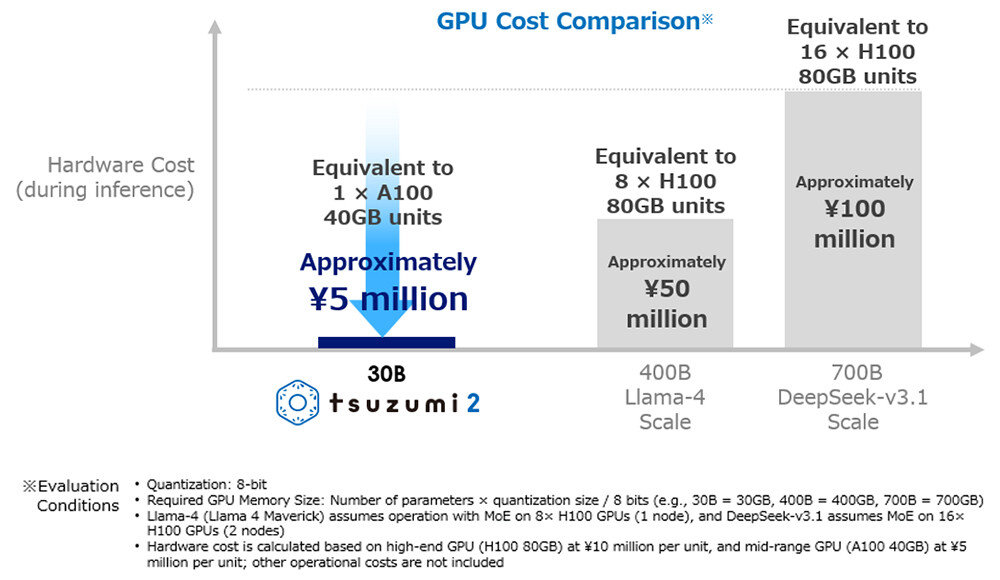Lightweight LLM powers Japanese enterprise AI deployments

Enterprise AI deployment has been facing a fundamental tension: organisations need sophisticated language models but baulk at the infrastructure costs and energy consumption of frontier systems.
NTT Inc.’s recent launch of tsuzumi 2, a lightweight large language model (LLM) running on a single GPU, demonstrates how businesses are resolving this constraint—with early deployments showing performance matching larger models at a fraction of the operational cost.
The business case is straightforward. Traditional large language models require dozens or hundreds of GPUs, creating electricity consumption and operational cost barriers that make AI deployment impractical for many organisations.
For enterprises operating in markets with constrained power infrastructure or tight operational budgets, these requirements eliminate AI as a viable option. The company’s press release illustrates the practical considerations driving lightweight LLM adoption with Tokyo Online University’s deployment.
The university operates an on-premise platform keeping student and staff data within its campus network—a data sovereignty requirement common across educational institutions and regulated industries.
After validating that tsuzumi 2 handles complex context understanding and long-document processing at production-ready levels, the university deployed it for course Q&A enhancement, teaching material creation support, and personalised student guidance.
The single-GPU operation means the university avoids both capital expenditure for GPU clusters and ongoing electricity costs. More significantly, on-premise deployment addresses data privacy concerns that prevent many educational institutions from using cloud-based AI services that process sensitive student information.
Performance without scale: The technical economics
NTT’s internal evaluation for financial-system inquiry handling showed tsuzumi 2 matching or exceeding leading external models despite dramatically smaller infrastructure requirements. This performance-to-resource ratio determines AI adoption feasibility for enterprises where the total cost of ownership drives decisions.
The model delivers what NTT characterises as “world-top results among models of comparable size” in Japanese language performance, with particular strength in business domains prioritising knowledge, analysis, instruction-following, and safety.
For enterprises operating primarily in Japanese markets, this language optimisation reduces the need to deploy larger multilingual models requiring significantly more computational resources.
Reinforced knowledge in financial, medical, and public sectors—developed based on customer demand—enables domain-specific deployments without extensive fine-tuning.
The model’s RAG (Retrieval-Augmented Generation) and fine-tuning capabilities allow efficient development of specialised applications for enterprises with proprietary knowledge bases or industry-specific terminology where generic models underperform.
Data sovereignty and security as business drivers
Beyond cost considerations, data sovereignty drives lightweight LLM adoption across regulated industries. Organisations handling confidential information face risk exposure when processing data through external AI services subject to foreign jurisdiction.
In fact, NTT positions tsuzumi 2 as a “purely domestic model” developed from scratch in Japan, operating on-premises or in private clouds. This addresses concerns prevalent across Asia-Pacific markets about data residency, regulatory compliance, and information security.
FUJIFILM Business Innovation’s partnership with NTT DOCOMO BUSINESS demonstrates how enterprises combine lightweight models with existing data infrastructure. FUJIFILM’s REiLI technology converts unstructured corporate data—contracts, proposals, mixed text and images—into structured information.
Integrating tsuzumi 2’s generative capabilities enables advanced document analysis without transmitting sensitive corporate information to external AI providers. This architectural approach—combining lightweight models with on-premise data processing—represents a practical enterprise AI strategy balancing capability requirements with security, compliance, and cost constraints.
Multimodal capabilities and enterprise workflows
tsuzumi 2 includes built-in multimodal support handling text, images, and voice within enterprise applications. Thismatters for business workflows requiring AI to process multiple data types without deploying separate specialised models.
Manufacturing quality control, customer service operations, and document processing workflows typically involve text, images, and sometimes voice inputs. Single models handling all three reduce integration complexity compared to managing multiple specialised systems with different operational requirements.
Market context and implementation considerations
NTT’s lightweight approach contrasts with hyperscaler strategies emphasising massive models with broad capabilities. For enterprises with substantial AI budgets and advanced technical teams, frontier models from OpenAI, Anthropic, and Google provide cutting-edge performance.
However, this approach excludes organisations lacking these resources—a significant portion of the enterprise market, particularly across Asia-Pacific regions with varying infrastructure quality. Regional considerations matter.
Power reliability, internet connectivity, data centre availability, and regulatory frameworks vary significantly across markets. Lightweight models enabling on-premise deployment accommodate these variations better than approaches requiring consistent cloud infrastructure access.
Organisations evaluating lightweight LLM deployment should consider several factors:
Domain specialisation: tsuzumi 2’s reinforced knowledge in financial, medical, and public sectors addresses specific domains, but organisations in other industries should evaluate whether available domain knowledge meets their requirements.
Language considerations: Optimisation for Japanese language processing benefits Japanese-market operations but may not suit multilingual enterprises requiring consistent cross-language performance.
Integration complexity: On-premise deployment requires internal technical capabilities for installation, maintenance, and updates. Organisations lacking these capabilities may find cloud-based alternatives operationally simpler despite higher costs.
Performance tradeoffs: While tsuzumi 2 matches larger models in specific domains, frontier models may outperform in edge cases or novel applications. Organisations should evaluate whether domain-specific performance suffices or whether broader capabilities justify higher infrastructure costs.
The practical path forward?
NTT’s tsuzumi 2 deployment demonstrates that sophisticated AI implementation doesn’t require hyperscale infrastructure—at least for organisations whose requirements align with lightweight model capabilities. Early enterprise adoptions show practical business value: reduced operational costs, improved data sovereignty, and production-ready performance for specific domains.
As enterprises navigate AI adoption, the tension between capability requirements and operational constraints increasingly drives demand for efficient, specialised solutions rather than general-purpose systems requiring extensive infrastructure.
For organisations evaluating AI deployment strategies, the question isn’t whether lightweight models are “better” than frontier systems—it’s whether they’re sufficient for specific business requirements while addressing cost, security, and operational constraints that make alternative approaches impractical.
The answer, as Tokyo Online University and FUJIFILM Business Innovation deployments demonstrate, is increasingly yes.
See also: How Levi Strauss is using AI for its DTC-first business model

Want to learn more about AI and big data from industry leaders? Check out AI & Big Data Expo taking place in Amsterdam, California, and London. The comprehensive event is part of TechEx and is co-located with other leading technology events including the Cyber Security Expo. Click here for more information.
AI News is powered by TechForge Media. Explore other upcoming enterprise technology events and webinars here.













